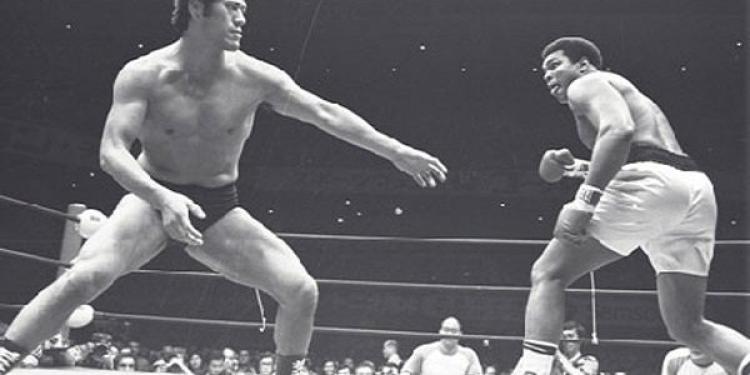Mixed Martial Arts for Beginners (part 2)
Posted: July 22, 2015
Updated: October 6, 2017

How Mixed Martial Arts gained greater respectability as a sport.
The Ancient Greek sport pankration combined striking and grappling was soon adopted by the Romans as an addition to their Greco Roman Wrestling. As more martial arts developed throughout the world, so did the desire for fighters to test their skills with one another. Competitions were held in Europe, Asia and the Pacific Rim throughout most of the 20th century.
• Muhammed Ali fought karate champion Antonia Inoki in Japan in 1976
• The first regulated MMA bouts in the U.S. occurred in 1980
• Since UFC, martial arts were restyled to accommodate grappling techniques
Boxers would be the first fighters to openly test their skills against wrestlers in public and soon other martial arts followed. Ed Parker developed a style called kenpo that included other techniques and made itself available for other improvements. At Ed Parker’s Martial Arts Invitational in Long Beach, CA, US gambling news was made when the world was introduced to a martial artist named Bruce Lee who explained his style of “form through formlessness” called Jeet Kun Do.
Major More modern developments in MMA

In 1976 Muhammed Ali, considered the greatest boxer in history, fought an exhibition match against karate champion Antonio Inoki in Japan. Both fighters who understood and respected each others’ discipline, mostly avoided each other for 15 rounds. Although the stalemate was considered a disappointment, Ali had to be hospitalized for three days due to damage in his legs from Inoki’s kicks. This event would become a precedent in demonstrating how “unorganized” two fighters from different styles can be upon confrontation with each other.
Another example of this is in 1988, when undefeated middleweight kickboxer Rick Roufus fought Muy Thai fighter Changpuek Kiatsongrit. Roufus knocked Changpuek down two times in the first round and broke his jaw. The Thai fighter had little experience fighting kickboxers and couldn’t adjust his style to adapt to Roufus. In the fourth round, Changpuek managed to knock out Roufus due to his lack of experience on how to adapt to Muy Thai’s low line kicks that were highly debilitating.
Vale Tudo, Brazilian fighting competitions, started in the 1920’s and favored Brazilian Jiu Jitsu. The grappling arts competition became an opportunity for the Gracie family to showcase their techniques. Carlos and Helio Gracie first issued these “Gracie Challenges” and later continued by their descendants in gyms, garages and eventually in carnivals. Japan also held mixed martial arts wrestling matches called Ishu Kakutogi Sen, meaning “heterogeneous combat sports bouts.” Inoki became celebrity during these bouts in the 1970’s.
VC Productions, Inc. presented the first regulated mixed martial arts competitions in the United States. Their “Tough Guy Contest” was first held in 1980 and soon changed its name to “Super Fighters.” By 1983, ten sanctioned tournaments were scheduled. These tournaments were held in Pennsylvania until the State Senate passed legislation that would change US gambling laws and prohibit these competitions.
The emergence of the Ultimate Fighting Championship

In 1993 regulated mixed martial arts competition was re-emerge in the U.S. Although the Ultimate Fighting Championship was officially considered a mixed martial arts tournament, it became instantly obvious that the competition favored grapplers. It was this competition where the term “mixed martial arts” was first used. The first competition had a variety of individualized disciplines such as ninjitsu, sumo wrestling, boxing, kenpo and muy thai, but these styles appeared awkward against each other.
The dreaded “octagon”, an eight sided ring enclosed in glass, became popular among viewers. With the help of the first victory by Brazilian Jui jitsui fighter Royce Gracie, who submitted three opponents in five minutes, UFC became an international sensation. Since Gracie’s victory, many people not only flocked to learn grappling, but also martial arts were restyled to accommodate grappling techniques.
It wouldn’t be long before audiences started to complain about the duration of the holds or “clinches” that occurred in matches. Soon the UFC incorporated rules limiting holds to keep fighters on their feet more. In addition, other fighters were starting to reveal “flaws” in the Gracie style. Royce won a match against a striker, but not before his ribs were broken. After it was revealed that the Gracie family had ownership interests in UFC, the family began to distance themselves from the tournament.
Strikers, who learned specific grappling techniques, were able to win the UFC competition. Although UFC was first considered a “human cock fight”, due to its lack of rules, soon respectability increased as more MMA competitions emerged throughout the world. Soon states sanctioned events and required MMA training for U.S. military troops became a reality.
The first UFC competition had a USD 50,000 prized, but gambling news was made when UFC 129 set a gate record of USD 12,075,000. Fox Sports network made a deal with UFC and since then similar MMA deals have been made with Spike TV, ESPN Star Sports and NBC sports. Since 2012, MMA tournaments with women have been broadcasted as well.












